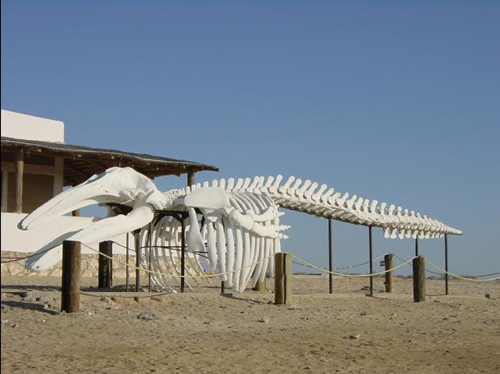Whale
Art
Draw a Gray Whale!
Gray whales are long, lean swimming machines, and among the sleekest members of the whale family. Appreciate their design with your own whale art.
Imagine! A 45-foot (14 m), 35-ton (38 tonnes) gray whale is about the same size and weight as 10 good-sized elephants. The tail-flukes alone weigh 300-400 lbs. (136-180 kg). The heart weighs over 285 pounds (130 kilograms). A large gray whale may carry several hundred pounds of hitchhiking barnacles living firmly attached to its head and body. How could you draw something this huge? Our clues will help you!

printer-friendly PDF list
of clues |
- About
30 to 50 feet (9 to 15 meters) long, gray whales have streamlined
bodies
with narrow, tapered heads that arch downward from a pair of
blowholes. The body tapers at both ends. (See drawing above.)
- The whole skull of the gray whale is disproportionately large. It takes up about a fifth of the total body length.

Photo Jane Duden
-
The upper jaw slightly overlaps the lower jaw. The curve of the mouth is long. From the side view, it appears to curve downward as if in a grimace, ending just under the eye.

Photo Caroline Armon
-
The eyes are located about 6 to 7 feet (2 meters) behind the tip of the snout, or roughly one-sixth of the distance from the front to the end of the whale.

Photo
Keith Jones
- Two blowholes, each about 8 inches (20 centimeters) long, are on top of the head. The blowholes are about the same distance back from the tip of the nose as the eyes.

Photo Caroline Armon
-
A gray whale has no dorsal (top) fin. A prominent dorsal hump rises about two-thirds of the way back on the body. The dorsal hump is followed by 6 to 12 bumps (knuckles) along the dorsal ridge that extend to the fluke, or tail.

Photo Steve Zabel
- Two large flippers (pectoral fins) are located behind and below the eyes. Each pectoral fin is four to five feet (1.2 to 1.5 m) long. The flippers are paddle shaped and pointed at the tips.
- Two to five shallow grooves furrow the ventral side (underside) of the throat. The grooves are about 5 feet (1.5 m) in length.

Photo Caroline Armon
-
The gray whale's fluke ( tail) is horizontal. It is about 12 feet (3.6 m) across, which is roughly equal to about one-fourth of the whale's entire length. The fluke is pointed at the tips, and deeply notched in the center. It looks rather like a flattened, pointy valentine.

- Gray whales are slate gray, but heavily mottled with white. The white is due to natural pigmentation, barnacles, and barnacle scars. Each whale has such a unique skin pigmentation pattern that individual whales can be identified by these patterns!

Photo CERF
- Take measuring tools outdoors or into the hallway and draw an actual size gray whale to illustrate their relative size.
- What physical characteristics help whales survive in their habitat? What other questions does this activity raise about anatomy and adaptations? List your questions in a journal or on a chart and record answers as you find them through research.
- Display everyone's finished drawings to reinforce the uniqueness of each gray whale.
National Science Education Standards
- Each plant or animal has different structures that serve different functions in growth, survival, reproduction.



